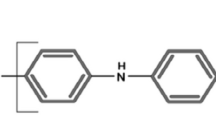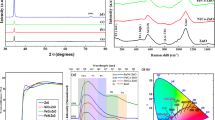Abstract
In this paper, the morphological and optical properties of LTO/TaOx composite structure films and electrochromic properties of “ITO/NiOx/LTO/TaOx/WOx/ITO” electrochromic devices (ECDs) based on LTO/TaOx composite structure films are reported. The composite films are deposited on the ITO substrate by reactive magnetron sputtering. The results of XRD, SEM, and AFM show that LTO film is amorphous and the performance of films prepared by sputtering power of 100 W for 5 h is the best. The optical transmittance of the multilayer structure is tested using an ultraviolet-visible spectrum and the refractive index dispersion is calculated using the relationship between the peaks in the spectrum based on equal inclination interference theory. Optical transmittance and refractive index dispersion are changed with the increase of magnetron sputtering power. Electrochromic tests show that all-solid-state ECDs based on composite films have 13 s coloring and 14 s fading response time, and the average optical modulation amplitude is 58%.











Similar content being viewed by others
References
Tajima K, Yamada Y, Bao S, Okada M, Yoshimura K (2008) Solid electrolyte of tantalum oxide thin film deposited by reactive DC and RF magnetron sputtering for all-solid-state switchable mirror glass. Sol Energy Mater Sol Cells 92(2):120–125. https://doi.org/10.1016/j.solmat.2007.01.022
Liu W, Zhang X, Liu J, Ma X, Zeng J, Liu P, Xu T (2017) Electrochromic properties of organic-inorganic composite materials. J Alloys Compd 718:379–385. https://doi.org/10.1016/j.jallcom.2017.05.222
Usha N, Sivakumar R, Sanjeeviraja C, Kuroki Y (2015) Effect of substrate temperature on the properties of Nb2O5:MoO3 (90:10) thin films prepared by rf magnetron sputtering technique. J Alloys Compd 649:112–121. https://doi.org/10.1016/j.jallcom.2015.07.097
Granqvist CG (2008) Oxide-based electrochromic materials and devices prepared by magnetron sputtering. In: Depla D, Mahieu S (eds) Reactive sputter deposition. Springer Berlin Heidelberg, Berlin, Heidelberg, pp 485–495. https://doi.org/10.1007/978-3-540-76664-3_13
Tajima K, Yamada Y, Bao S, Okada M, Yoshimura K (2008) Proton conductive tantalum oxide thin film deposited by reactive DC magnetron sputtering for all-solid-state switchable mirror. J Phys Conf Ser 100(8):082017. https://doi.org/10.1088/1742-6596/100/8/082017
Tajima K, Yamada Y, Bao S, Okada M, Yoshimura K (2007) Durability of all-solid-state switchable mirror based on magnesium–nickel thin film. Electrochem Solid-State Lett 10(3):J52. https://doi.org/10.1149/1.2430568
Poongodi S, Kumar PS, Mangalaraj D, Ponpandian N, Meena P, Masuda Y, Lee C (2017) Electrodeposition of WO 3 nanostructured thin films for electrochromic and H 2 S gas sensor applications. J Alloys Compd 719:71–81. https://doi.org/10.1016/j.jallcom.2017.05.122
Gaikwad DK, Mali SS, Hong CK, Kadam AV (2016) Influence of disordered morphology on electrochromic stability of WO3/PPy. J Alloys Compd 669:240–245. https://doi.org/10.1016/j.jallcom.2016.01.226
Wang S-C, Liu K-Y, Huang J-L (2011) Tantalum oxide film prepared by reactive magnetron sputtering deposition for all-solid-state electrochromic device. Thin Solid Films 520(5):1454–1459. https://doi.org/10.1016/j.tsf.2011.08.046
Liu CC, Liu KI, Lin HT, Huang JL (2012) Magnetron sputtering of tantalum oxide thin electrolyte film for electrochromic applications. Key Eng Mater 512-515:1604–1608. https://doi.org/10.4028/www.scientific.net/KEM.512-515.1604
Saito T, Ushio Y, Yamada M, Niwa T (1990) Properties of tantalum oxide thin film for solid electrolyte. Solid State Ionics 40:499–501. https://doi.org/10.1016/0167-2738(90)90389-9
Wang SC, Liu KY, Huang JL (2011) Tantalum oxide film prepared by reactive magnetron sputtering deposition for all-solid-state electrochromic device. Thin Solid Films 520(5):1454–1459
Wang M-C, Chen Y-C, Hsieh M-H, Li Y-C, Wang J-Y, Wu J-Y, Tsai W-F, Jan D-J (2016) The improvement of all-solid-state electrochromic devices fabricated with the reactive sputter and cathodic arc technology. AIP Adv 6(11):115009. https://doi.org/10.1063/1.4967363
Wang M-C, Hsieh M-H, Chen Y-C, Wang J-Y (2016) All-solid-state electrochromic device integrated with near-IR blocking layer for image sensor and energy-saving glass application. Appl Phys Lett 109(12):123501. https://doi.org/10.1063/1.4962842
Tajima K, Yamada Y, Bao S, Okada M, Yoshimura K (2009) Electrochemical evaluation of Ta2O5 thin film for all-solid-state switchable mirror glass. Solid State Ionics 180(6–8):654–658. https://doi.org/10.1016/j.ssi.2008.12.034
Dong D, Wang W, Dong G, Zhang F, He Y, Yu H, Liu F, Wang M, Diao X (2016) Electrochromic properties and performance of NiO x films and their corresponding all-thin-film flexible devices preparedby reactive DC magnetron sputtering. Appl Surf Sci 383:49–56. https://doi.org/10.1016/j.apsusc.2016.04.154
Du C, Tang Z, Wu J, Tang H, Zhang X (2014) A three volt lithium ion battery with LiCoPO4 and zero-strain Li4Ti5O12 as insertion material. Electrochim Acta 125:58–64. https://doi.org/10.1016/j.electacta.2014.01.093
Pan H-L, Hu Y-S, Li H, Chen L-Q (2011) Significant effect of electron transfer between current collector and active material on high rate performance of Li4Ti5O12. Chinese Physics B 20(11):118202. https://doi.org/10.1088/1674-1056/20/11/118202
Ohzuku T (1995) Zero-strain insertion material of li[Li1∕3Ti5∕3]O4 for rechargeable Lithium cells. J Electrochem Soc 142(5):1431. https://doi.org/10.1149/1.2048592
Xie J, Harks P-PRML, Li D, Raijmakers LHJ, Notten PHL (2016) Planar and 3D deposition of Li4Ti5O12 thin film electrodes by MOCVD. Solid State Ionics 287:83–88. https://doi.org/10.1016/j.ssi.2016.02.004
Li C-L, Zhang B, Fu Z-W (2006) Physical and electrochemical characterization of amorphous lithium lanthanum titanate solid electrolyte thin-film fabricated by e-beam evaporation. Thin Solid Films 515(4):1886–1892. https://doi.org/10.1016/j.tsf.2006.07.026
Tiwari KJ, Vinod V, Subrahmanyam A, Malar P (2017) Growth and characterization of chalcostibite CuSbSe2 thin films for photovoltaic application. Appl Surf Sci 418:216–224. https://doi.org/10.1016/j.apsusc.2017.01.279
Mannequin C, Tsuruoka T, Hasegawa T, Aono M (2016) Identification and roles of nonstoichiometric oxygen in amorphous Ta2O5 thin films deposited by electron beam and sputtering processes. Appl Surf Sci 385:426–435. https://doi.org/10.1016/j.apsusc.2016.04.099
Gao Z, Myung Y, Huang X, Kanjolia R, Park J, Mishra R, Banerjee P (2016) Doping mechanism in transparent, conducting tantalum doped ZnO films deposited using atomic layer deposition. Adv Mater Interfaces 3(21):1600496. https://doi.org/10.1002/admi.201600496
Donaldson OK, Hattar K, Trelewicz JR, Johnson EIC (2016) Metastable tantalum oxide formation during the devitrification of amorphous tantalum thin films. J Am Ceram Soc 99(11):3775–3783. https://doi.org/10.1111/jace.14384
Hu YM, Li JY, Chen NY, Chen CY, Han TC, Yu CC (2017) Effect of sputtering power on crystallinity, intrinsic defects, and optical and electrical properties of Al-doped ZnO transparent conducting thin films for optoelectronic devices. J Appl Phys 121(8):085302. https://doi.org/10.1063/1.4977104
Sun G, Cao X, Gao X, Long S, Liang M, Jin P (2016) Structure and enhanced thermochromic performance of low-temperature fabricated VO2/V2O3 thin film. Appl Phys Lett 109(14):143903. https://doi.org/10.1063/1.4964432
Özen S, Şenay V, Pat S, Korkmaz Ş (2016) Optical, morphological properties and surface energy of the transparent Li4Ti5O12(LTO) thin film as anode material for secondary type batteries. J Phys D Appl Phys 49(10):105303. https://doi.org/10.1088/0022-3727/49/10/105303
Kalita DJ, Lee SH, Lee KS, Ko DH, Yoon YS (2012) Ionic conductivity properties of amorphous li–La–Zr–O solid electrolyte for thin film batteries. Solid State Ionics 229:14–19. https://doi.org/10.1016/j.ssi.2012.09.011
Oudenhoven JFM, Baggetto L, Notten PHL (2011) All-solid-state Lithium-ion microbatteries: a review of various three-dimensional concepts. Adv Energy Mater 1(1):10–33. https://doi.org/10.1002/aenm.201000002
Huang ZY, Chen M, Pan SR, Chen DH (2010) Effect of surface microstructure and wettability on plasma protein adsorption to ZnO thin films prepared at different RF powers. Biomed Mater 5(5):054116. https://doi.org/10.1088/1748-6041/5/5/054116
Muchuweni E, Sathiaraj TS, Nyakotyo H (2016) Physical properties of gallium and aluminium co-doped zinc oxide thin films deposited at different radio frequency magnetron sputtering power. Ceram Int 42(15):17706–17710. https://doi.org/10.1016/j.ceramint.2016.08.091
Kim DK, Kim HB (2015) Properties of ZnO:Ga thin films deposited by RF magnetron sputtering under various RF power. Applied Science and Convergence Technology 24(6):242–244. https://doi.org/10.5757/asct.2015.24.6.242
Duygulu NE (2015) Effect of r.F. Power variation on gallium doped zinc oxide thin films. Vacuum 120:19–27. https://doi.org/10.1016/j.vacuum.2015.05.036
Emam-Ismail M, Shaaban ER, El-Hagary M (2016) A new method for calculating the refractive index of semiconductor thin films retrieved from their transmission spectra. J Alloys Compd 663:20–29. https://doi.org/10.1016/j.jallcom.2015.12.071
Usha KS, Sivakumar R, Sanjeeviraja C (2013) Optical constants and dispersion energy parameters of NiO thin films prepared by radio frequency magnetron sputtering technique. J Appl Phys 114(12):123501. https://doi.org/10.1063/1.4821966
Acknowledgements
This work is supported by the National Natural Science Foundation of China (Grant No. 51602045), the Fundamental Research Funds for the Central Universities (Grant No. N162304013), and the Natural Science Foundation of Hebei Province (Grant No. E2017501082), Natural Science Foundation of Liaoning Province (No.20170540325).
Author information
Authors and Affiliations
Corresponding author
Electronic supplementary material
ESM 1
(PDF 709 kb)
Rights and permissions
About this article
Cite this article
Wang, B., Wang, X., Li, M. et al. Study on the optical properties and electrochromic applications of LTO/TaOx ion storage-transport composite structure films. Ionics 24, 3995–4003 (2018). https://doi.org/10.1007/s11581-018-2557-8
Received:
Revised:
Accepted:
Published:
Issue Date:
DOI: https://doi.org/10.1007/s11581-018-2557-8




